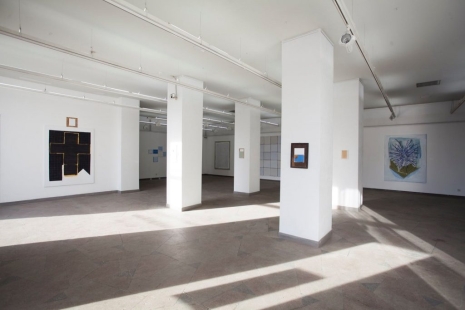Morta Difartaitė: “My work of the last couple of years has a distinctly Soviet smell (a particularly sensitive topic in the current context). The latter can be understood here as a metaphor, and those with a good sense of smell might be able to sense it coming from the carpets that I sometimes use instead of canvas in my paintings. The Soviet era is one of the periods that seems relatively long gone, but its aftermath still lingers on in the form of artefacts, landscape, architecture, interiors, people’s consciousness and their stories. This subject has been touched upon and explored in some depth by older generations of artists, but I am curious about what the relationship of my generation, born in a free country, is to this bygone era.
I gather images from my family’s personal archive of photographs, most of which are from the no longer existing kindergarten “Pumpurėlis” in a no longer existing town called Kapsukas. I look at the characters in these photos as specific personalities, guessing what they are thinking, agreeing or arguing with them, and thus expressing the dialogue on the surface of the canvas by telling stories that are partly of my own creation. By painting the cheeks of cute kindergarteners red, I think about contemporary issues and current affairs, also trying to get a clearer understanding of my own psychology (of a generation limited in time and place). In this way, the analysis of archival photographs is intertwined with my own feelings and personal experiences, which, being particularly complicated, I believe are not only specific to me, but also to a wider circle of people who have already been born free.
Every now and then, three stripes pop up in my paintings. Considering that the imagery I use in my paintings is from the Soviet era, when Adidas products, like peppers, did not exist, you might think that I am making factual and logical errors, but I am doing it intentionally. The Little Octobrists, the pioneers and the Komsomol used to decorate their uniforms with scarves, which may mean nothing to people born in a free Lithuania, and also to Westerners, but to the Soviet generation it remained an involuntary symbol of selling the soul. While the East wore scarves, the West wore Adidas. By dressing a group of children from Eastern Europe in tracksuits with three stripes, I am symbolically building a bridge to the West.
When I paint, I choose the mode of expression and the colour palette intuitively – the motif itself dictates it. When I look at a photograph, it lights up (or doesn’t) in the colours it needs. So, I have to admit, I surrender myself to the painting, it is at my command to the extent that I allow myself to consciously communicate with it. The conversation on the surface of the canvas takes place in the depths of intuition and subconscious or involuntary recollection, and in the contemplation of the composition of the plastic image.
I called the exhibition “Toffee”, the name of a well-known candy that has a strong association with the Soviet era („Iris“). Now it is just a sign – that time, like the candy, no longer exists – only the papers are left. And the taste in the memories of some.
By the way, the iris flower is a symbol of new beginnings.”
“Toffee” is part of the “Graduation Show” series in collaboration with Vilnius Academy of Arts.
Organiser: Pamėnkalnio Gallery.
Sponsors: Lithuanian Council for Culture, Vilnius City, Lithuanian Artists’ Association.
Partner: Vilnius Academy of Arts.
Working hours: II–V 11–19, VI 11–16.





